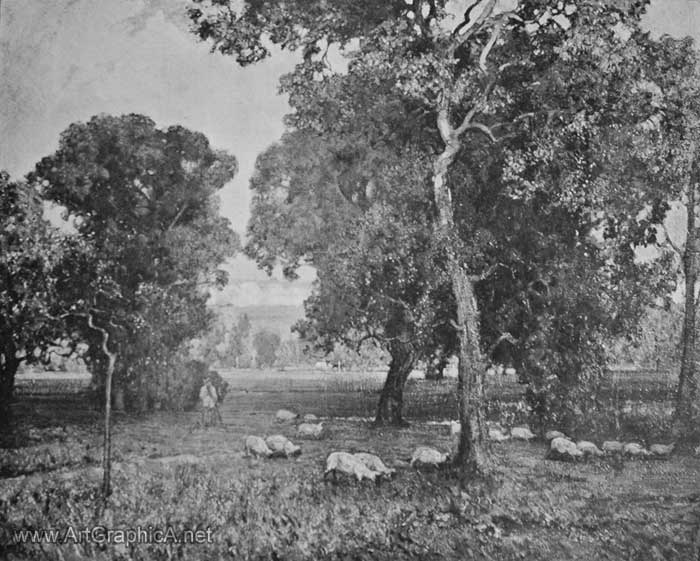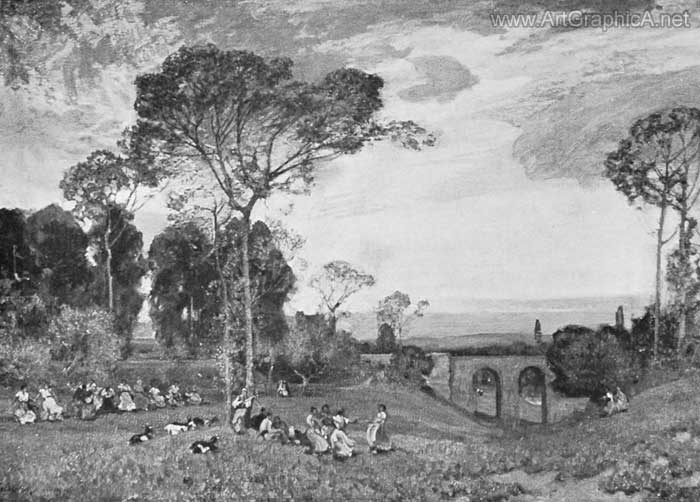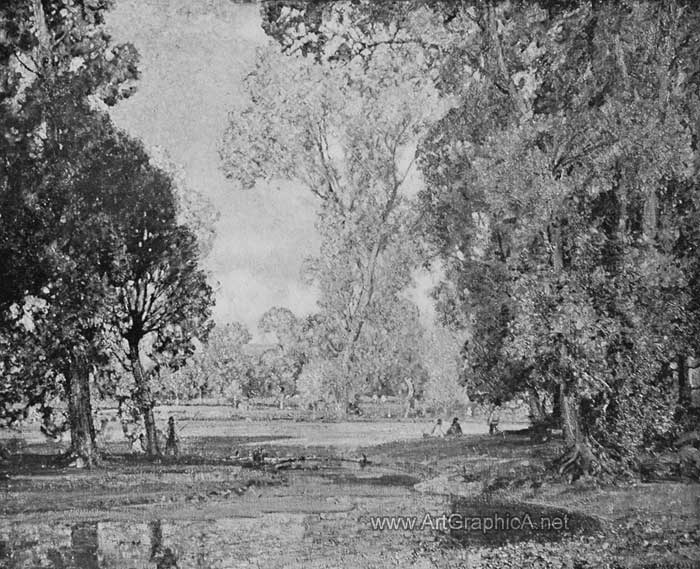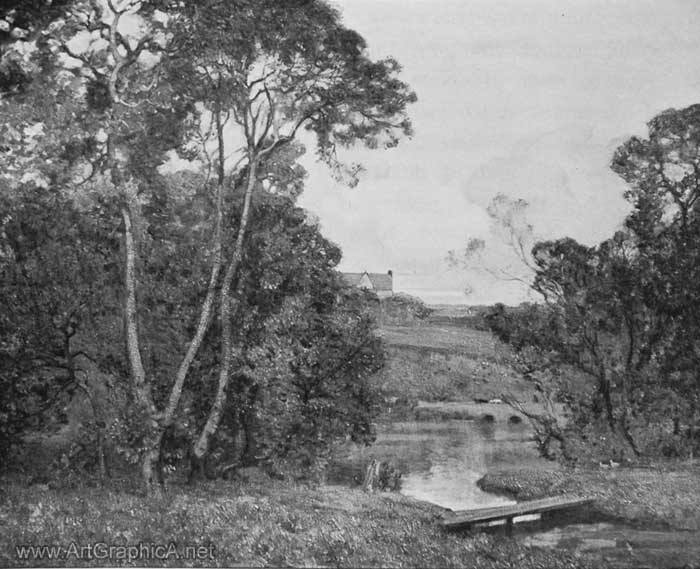Plein Air |
||||||||||||||||||||||||||
|
Page 14 / 14
PAINTING FROM NATURECHAPTER XIIIA GREAT deal of discussion has taken place as to the advantage or otherwise of painting large pictures direct from Nature. A school, calling itself the "Plein air" school, made this principle their party-cry. There may have been a reason for this, as landscape painting had become to a large extent a mere formula, a combination of recipes handed down by the old conventionalists, and had the odour of the studio; it wanted a breath of fresh air to revivify it. The "Pin air" school did, in some respects, accomplish this, although its methods may have been pushed beyond legitimate limits; but all the faults combined of the new school were better than the artificial procedure of the older method. Painters awoke from their lethargy, and felt that in the freedom and individuality of the example of Constable and others a new era had arrived, in which it was possible for art to make advances parallel with progress in other departments of human achievements, though it was years before the more natural attitude received its due recognition. Artists now posed their peasants in the open air, and painted the effect of sunlight upon them, from immediate observation, and studied with direct vision the subtle effect of light, shade, and colour. Landscape painters took out their large canvases to Nature, and painted the subject before them on the spot. The difficulties were not lessened. But the question arose: "Was it possible by this method to secure the freshness of Nature, the sense of its atmosphere and illumination ?" Undoubtedly it was; but difficulties beset the path of these men, which have still to be faced and overcome. The great danger was of following the changing light instead of painting an effect of the moment. It frequently happened that, in the large landscapes so painted, the effects of sunshine were crossed, that is, that instead of being positive as in a sketch, they were distributed or expressed with more or less hesitation and lack of definite purpose. It was difficult to avoid falling into this error. The temptation was always present to paint the thing one saw at the moment, forgetting that five minutes later the sun would be blazing upon a surface which was now in shadow. If the effect of light on that portion of the picture were true to Nature, by the time you had painted it, the effect in another portion of the picture would be false. The only way out of the difficulty was to paint for a short time every day while the effect was on, at the same time correcting the values and having the courage to retain them while finishing the picture. Of course, this plan would not insure that you had the colour scheme before you long enough to get a satisfactory result, but you would have your sketches to keep you right in respect to the large masses of your subject. If you ventured in the spring to paint a picture of apple-blossom, probably you would find that the blossoms would have faded before the picture was done. Or you might paint a subject that mainly depends upon its colour. The rain descends, your large canvas is brought indoors, and by the time the weather has again become suitable, the whole of your effect has changed, it no longer offers the attractive combination of colour which had induced you to paint it. Such are the difficulties one has to contend with in painting a large picture from Nature. The diffi culties, of course, diminish with the reduction of size of your canvas, since you have a greater command over the smaller area. if", therefore, you care to make the experiment of painting, say a five- or six-foot picture, direct from Nature, you should, in the first place, make sure that the subject is not liable to rapid change. When you have discovered one that excites your enthusiasm, start by drawing an outline of your composition in charcoal, using as big a stick as possible. When you have done so satisfactorily, re-draw over the lines with a lead pencil, then brush off the charcoal ; but before doing so, it is as well either to rub your canvas down with pumice stone or wash it with benzine to take off the greasiness of its surface before starting. That had better be done before you draw upon it.  A Gleam Before the Storm. Plein air. * I remember a painter, who was a determined " sticker" to Nature, starting a picture of apple- blossom. He commenced his picture well ahead of the full development of the flowers, and with dogged determination made up his mind to "go for it." He painted the blossom with painstaking efforts to realise it according to his ideal of perfection. Conscientiously he altered his picture with the changing aspects of Nature, till, at length, the blossom vanished, the full-grown leaves appeared' and the young fruit was developed. When I saw the picture finished it was called "Gathering Apples"\! Now since you have made your drawing you can begin to paint. Set your palette generously. Don't, for heaven's sake, use a starved palette I Be prepared, if I may so express it, to waste all your colour sooner than get a thin picture. Have your dipper big enough to take a large brush. Assuming then that you have set your palette with plenty of white, and the colours arranged as I have already described,* start to paint with confidence. Work freely from your shoulder, with your large canvas upright and at such a height that you can work standing--that is, the centre of the canvas should be a little lower than the palette hand, so that each part can be reached without fatigue. Paint in your large masses broadly--which you will observe in Nature the more readily by half closing your eyes--but in their absolutely correct values and right relation to each other ; look for the contours of your lights and darks, then paint fearlessly and frankly. Do not at this stage worry about details, but look for the large things, remembering that the shape of one mass forms the shape of the mass of another. For instance the outline of the trees describes the form of the light of your sky. Your subject must be reduced to its simplest proportions. Broadly speaking, it will comprise but two or three salient quantities. The darkest are your trees, the lightest your sky, with the grass forming a middle tint. Of course this remark is merely a general one These masses may, and will, vary according to the subject you are painting. But what I insist upon is, that in the preliminary stage of your picture you paint the effect that you wish to secure, and as you cannot begin with details, the only plan is to block in the masses with a big brush while the effect is on. This should be done at a single painting if possible. * See Chapter III., Sketching from Nature Do not trouble about anything else. If for example you cannot paint the whole of the foreground, paint a passage of it, so that it records the exact colour in relation to the trees above it ; and proceed in like manner with the sky. It is essential that all these things which are chiefly affected by the rapidly changing effect must receive your attention at the moment, a splash of colour of the right tone is better at this stage than the careful drawing of the contour of a branch, for the one effect is transitory and the other will wait.  After the Fete. Before you commence a large picture, I should strongly advise you to study your subject for some days, and to see it under various aspects and conditions. It is not pleasant to discover, when the picture is half finished, that it has not been painted under the best effect. Such study is not lost time, for apart from your definite purpose, there is the knowledge you gain of Nature. You become so intimately acquainted with your subject that you know how it is put together, and of what it is composed. You should also make sketches in colour under the same conditions you elect to paint your picture, and also make pencil drawings to familiarise you with its forms. Do not think such energy is misspent. Curb your impatience to get at your picture; I know it requires an effort to do so, but believe me, the wider your knowledge of your subject prior to painting it on your canvas, the greater are the probabilities of success. I would almost go as far as to say that you should know it well enough to paint it from memory, but that would obviously be travelling beyond the range of painting direct from Nature. The advantage of painting from Nature is that you gain confidence. Confidence comes of knowledge, and that means spontaneity, one of the qualities which can be worth nothing if it is not obtained by intense consciousness. You have now, we will suppose, your six-footer covered--never mind how roughly or how broadly, as long as you have correctly laid in your values. I do not know if it is necessary to explain what I mean by values. As we use the term in art, it means the truth of one tone in relation to another as compared with Nature. For example, if I pitch my picture as near as I can to the pitch of Nature, and paint one passage exactly of the same intensity or tone as the same passage in Nature, I have struck the key, as it were, in which my tune must be played. I can, of course, transpose it by striking a new key. I can paint the passage I speak of in a lower tone, but all the other tones in the picture must be lowered in the same relation to one another as they are in Nature. For instance, I call the pitch of Nature "A." Say that in Nature it is glowing sunlight, and that it is impossible for any pigment to reach so high a key of colour, I am forced to lower my key to "F." In Nature all colours are in relation to " A," and in my picture, in which the "A" has been reduced to " F," all my tones must, of course, be in relation to " F." If there is 40 per cent difference between the light and shade in Nature, there must be 40 per cent. difference between the light and shade of my picture, no matter what the pitch of my picture may be. At this moment, do not concern yourself with finish ; you have meanwhile presented your subject in its simplest proportions. If it has been expressed in a high key (and I should always advise your doing so), the various masses of colour should be in exact relation, and the resulting harmony gives the quality of tone. Step back fifty or sixty paces from your canvas, and you will be pleasantly surprised to find (if these conditions which I insist on be observed) how like Nature it is, for the distance in diminishing its size has made you unaware of the absence of details. Your picture should now wait till it is dry. You have, I hope, painted it with a generous brush, and very little, if any, medium. You have put on the paint with due regard to the texture of the material before you, and in order to prevent cracking, two courses are open to you--either follow the method as described, or continue your picture while it is wet, which is the more difficult to do. The danger of cracking arises generally from the superimposition of fresh colour upon a tacky or half-dried surface, more particularly in the case of a fast-drying paint over a slow one. The fault of cracking is not caused by the inferiority of paint or of medium, but by carelessness or indifference in the actual process of painting. The safest way, when painting a large picture from Nature, is to let it dry thoroughly after you have finished the laying-in, and see that it is thoroughly dry before you begin to work upon it again. Flake white dries in a few days, but as it dries from the surface it may mislead you; although it appears to be quite dry, you will find that it is only superficially so, and is not solid underneath the skin. On the other hand, if you use zinc white you know that if it is dry on the surface it is solid underneath. The advantage of flake white is that it works more freely and is more elastic than zinc, although it yellows more quickly by time, while zinc white, when quite hard, has less elasticity, and its brittle quality lays it open to some objections. I use the new flake white (see p. 10), which, I think, has some of the good qualities of both without their drawbacks. If you have used this white, which dries from the bottom, you can, where necessary, scrape off any obtruding brush marks that have been left in the excitement of making the dbamhe, or first rub in. If you use the ordinary flake white, which dries from the top, you must be careful in scraping lest you make an ugly scar, which will afterwards be difficult to disguise. A cuttle-fish bone is safer to employ than a scraper, since it grinds down the surface evenly. You must now "oil out" your picture with a little poppy oil, rubbing it well in and wiping off all that is superfluous. Then, with as big a brush as possible, you may recommence the correction of your masses. In this stage of your picture, keep it well under your command. Do not under any consideration attempt to finish it or any part or portion of it. Still direct your chief attention to the ensemble, and disregard details. Keep the whole thing as simple and as fresh and spontaneous as possible. Do not be afraid, and do not hurry ; and if your progress is apparently slow, never mind. You have made a real advance. A bad work is more often the result of hasty and ill-considered finish than of defective skill. Continue to paint thoughtfully, closely observing the essentials, the big facts of the truth of light and shade, of the relation of colour to colour, of contour to contour, modelling the branches of your trees, painting with broken colour your foreground of grass with plenty of paint, so treating it that the brush marks will suggest the material. Always remember that each touch must have a meaning, some useful purpose to serve towards your desired end. As you paint you also draw. The brush must develop the truth of form as well as of colour. You are, at this stage, building up as it were the various surfaces for the reception of a final finish, and that will evolve itself without effort. Your picture will finish itself, for finish is simply the climax of self criticisms and of careful balancing of effects and relations in comparison with Nature. The treatment of Nature in art is greatly a matter of the personal temperament of the painter. no doubtan artist is attracted by the small things in Nature, which are doubt in themselves very beautiful, he will seek to reproduce them and the result will, in the estimation of those who arc in the habit of looking for little things, be very satisfactory and highly finished. But if these details are of no service in the expression of the large essential verities, then they are worse than useless. Aim at the great things, which include the details, making them subordinate as in Nature, and placing them in due relation to the whole. If on the other hand you concern yourself with petty though possibly charming trivialities, they may worry and fret you because they hinder your appreciation of what is great. In correcting the surfaces where the brush marks are not consistent with the material represented, you must hear in mind that there is a perspective of texture. For instance, the extreme distance in the sky and landscape must not show the coarse texture of the foreground. The remote sky always gives one the feeling of having a fine surface which changes as it rises to the zenith. That is my impression, and I paint it so. The same principle holds good in the landscape itself; I feel the texture of the distance to be smoother than the foreground, and the difference, expressed on the canvas, increases the sense of aerial perspective. You will of course have a knowledge of the elementary rules of linear perspective, but the perspective of the landscape painter is not so much concerned with actual lines as with imaginary ones. He must bear in mind that the land is more or less flat, and not an upright diagram with the diminishing objects as the only proof of distance. The one great strong line in Nature is that which is felt rather than seen, upon which the mountains base themselves, and the undulations of the fields appear to follow. Upon this imaginary line everything rests, and it must be felt in any landscape that aspires to strength and certainty.  Autumn in the Valley of the Ouse. Plein air. The landscape painter must carefully study the influence of atmosphere upon the lessened dimensions of remoter objects, and remember that his tone values must be just, and this is intimately associated with the truth of aerial perspective. For instance, if a yellow tree appears on the same plane as a green one in an autumn landscape, it will be easy enough to portray them in their right size in relation to your foreground. But a difficulty may arise when you try to paint them both in the same atmospheric plane. It stands to reason that, if an equal breadth of air intervenes between you and both trees, you have a colour problem to deal with now, for it is essential that they appear by reason of colour as well as size to be at the same distance from the observer. The lesson to bear in mind is, that your aerial perspective must always be consistent with your linear perspective. Remote objects occasion difficulties, no doubt, but do not try to make them recede by diluting your foreground colour by the addition of white. You cannot reach the result by such means; you must have a different set of pigments. The strong hues of your foreground, broken, as in Nature, into a hundred details, may be composed of cadmium of three grades of strength, of rose madder, and white, with burnt sienna broken with white and transparent emerald oxide of chromium, and transparent golden ochre. All these are broken together on your picture (see Chapter III., Sketching from Nature), not mixed on your palette. But for the extreme distance your colour should be mixed on your palette. For the intermediate distance you use paint not so flat as in the extreme distance, but not so broken as in your foreground. You have now, with plenty of paint and very little medium, practically repainted your picture. You have gone over most of the surface, except perhaps the shadows, which should not be thickly painted. You have modelled your trees, painted the middle distance, prepared the foreground with broken colour, and, above all, you have retained the original freshness of your effect-- that first impression which imparted vitality to the subject. Nov let me speak of the sky. It is as you left it in your first painting--merely a ground of white, toned with yellow ochre. You will probably have seen many cloud forms pass during your work up to this point, and you know in your mind, which will best harmonise with your composition. But still it is better to watch when your effect comes on, so that you may note the particular colour of the sky in relation to the trees, and in the same relation of colour paint it in your picture. But one moment--the form of the clouds that you perceive yonder may or may not suit your scheme. You will be fortunate indeed if they harmonise absolutely. No matter how beautiful your clouds may be, if they do not suit the contours of your picture you must avoid them, and accept only such as support and complete it, and are consistent with the character of the day. You must paint the sky again with the same tint as you used previously, a little warmer at the horizon, and cooler above. Then mix the blue on your palette, rather more strongly than is really needed, for the reason which I have already explained. You are now ready. You watch for your effect, which is coming on. You know it occurs at the moment of impact of that shadow upon the mass of trees which you have noted before. It is the supreme crisis when everything, as it were, will sing in tune. The clouds roll majestically forward and reveal the very form you desire. You are, of course, standing at your easel. No man ever painted a great sky sitting. You hold your breath in the excitement of the moment, you know what it means to your work ; but do not hesitate, do not flinch. Take up the blue in your brush and draw the sky, which will give the edge of the clouds. Watch with attention the exquisite gradation of tone where it shows itself above the cloud to the top of your picture, to where it touches your extreme distance. The form and colour gradation of a good sky will convey a sense of perspective as truly as the landscape below. You have now secured the tone and form of sky which is in sympathy with the other parts of your picture. You have painted in your blue, so little after all, but with a risk out of all proportion to its area. Your clouds may be now modelled with more deliberation, painting them with grey at the undersides--a grey composed of rose madder, cobalt and yellow ochre. (See chapter on Painting Skies.) If the under painting be properly prepared, the sky should be finished at one painting, though this purpose must necessarily be governed by size and other obvious circumstances. But what I want you to do now, and what is at this point of more importance, is to paint the sky into the edge of the trees. You will remember how in another chapter I discussed the method of dealing with this borderland of sky and foliage. Your picture having been brought to this point, you begin to feel you are within measurable distance of the end. Here I suggest that, if the conditions of Nature are favourable, and there is no probability of a change in your subject, you should give the canvas a rest in order to let it dry. Again bear in mind that you cannot patch blue. If you have failed in the sky, the better plan is to take it all oft' to the under layer with an ivory palette knife and begin afresh. So few artists paint a blue sky well because they try to patch up the blue. It is difficult to paint a white cloud on a blue sky. It will always be a patch. Of course, after many years of experience you may be able to venture on some things which it would have been insane to attempt at an earlier stage, and this of adding blue to blue is one. Your picture is dry; you have oiled it out, and taken it to Nature again. You may have thought the time consumed for the preliminary studies was wasted, but, believe me, it is by these studies that you gain the knowledge and confidence which enable you to reach a successful issue. Suppose it had commenced to rain, and continued raining, or that the atmosphere had remained grey for some considerable time, and at the end of this period the weather cleared only to reveal the fact that the trees and grass had completely changed their colour! What then ? As I have said before, your studies would be of the greatest value as reference. Here you find the benefit of the policy of making careful sketches and studies before commencing your picture. But if you are fortunate enough to have a continuation of suitable weather, you will have the opportunity of comparing the component parts of your picture with each other and Nature during the time the effect is maintained.  Evening in the Cotswolds. Plein air. You now watch keenly for the subtle and more indefinite passages of colour, such as the reflected or re-reflected lights which give it quality. As style depends mainly on the dignity of your composition, so quality depends upon the realisation of the more indefinite variations which make up the masses. You now select from Nature just those things that will sustain the character of your material. Your trees cannot show every leaf. Although there are those who have thought otherwise, like the old Dutch landscape painters, they have come to grief. You must realise what is infinitely finer--the portrayal of foliage so as to indicate aggregation of leaves in the suggestion of the mass. Your painting must give the sensation that the masses of foliage are made up of multitudes of leaves, though they are not separately indicated. A house in the middle distance you know is built of bricks, but you would not for one moment think of depicting the individual courses ; you would treat the wall as a tone of colour, and let that suggest the material. Or, take another case. Under the trees some cows are resting, and the sunshine dapples over them a pattern of light and shade. You know full well that the red and white, and the light and shadow of their hides, arc composed of multitudes of fine hairs, but you do not dream of attempting the task of painting them. At the same time you should not paint the cattle as you would a door; with flat paint that would reveal nothing of the truth of the material it is intended to represent. So with trees and grass. Our knowledge informs us that the grass field on the distant hillside is green. But hold up a few blades of the same material at arm's length for comparison, and you will find that the apparent distant "green" is not green at all, because of the effect of the intervening atmosphere. You have to paint it so as to render the same impression as that of Nature, and to convince the spectator that though you paint it a yellow or blue- grey, it is identical in colour with the meadow at your feet.* Many illustrations could be added, if necessary, to emphasise this principle, but I have said enough I think to convince you of the absurd notion, promulgated by some, that the closer imitation of Nature in detail shows greater knowledge. It is not so. The subtler knowledge of Nature is evinced by the artist who knows Nature so well that he can adapt it to his own purpose. It is so in all things. The writer and the musician proceed on the same method. It would be absurd to say that the mere reproduction of natural sounds is music, or that a faithful description of a locality in a guide book is literature. I remember an exhibition of landscapes which were submitted in competition for a prize. Although the prize was offered for a landscape, it was given to the painter of a careful study of rushes on a river bank. No doubt it was a faithful study, and the rushes were excellently painted, but it was not a landscape ; and all those who had painted landscapes were naturally surprised at the award. Its supposed merit consisted in the most servile imitation of Nature, which excluded every particle of the personality of the painter, and only the abject ignorance of the character of things was revealed. It will be interesting to follow the career of that young artist if he paints his landscapes in that spirit. He would have done better had he learnt more of the possibilities of the growth of his rushes, so that he could include them in any form when it was necessary. Your picture may be said to be finished when it would be superfluous to add another touch to it, and when it rings in perfect harmony and rhythm of line and mass of tone and colour. The beauty and dignity of your composition, your scheme of colour, and all the personal and individual expression of your painting, should be full of that great quality which must be the dominant note of your picture, and that is the expression of the vital force and the convincing truth of Nature. * See chapter on Drawing Grass I have already pointed out the advantage of making studies direct from Nature, as aids to painting. How valuable, then, are studies of colour effects to those who paint their most important pictures in the studio, and who must, of necessity, depend upon them, and upon their recollection and impressions, for the truth they wish to convey. By Alfred EastThe End
Next Page
Prev PageLandscape Painting What to Paint
|
||||||||||||||||||||||||||








